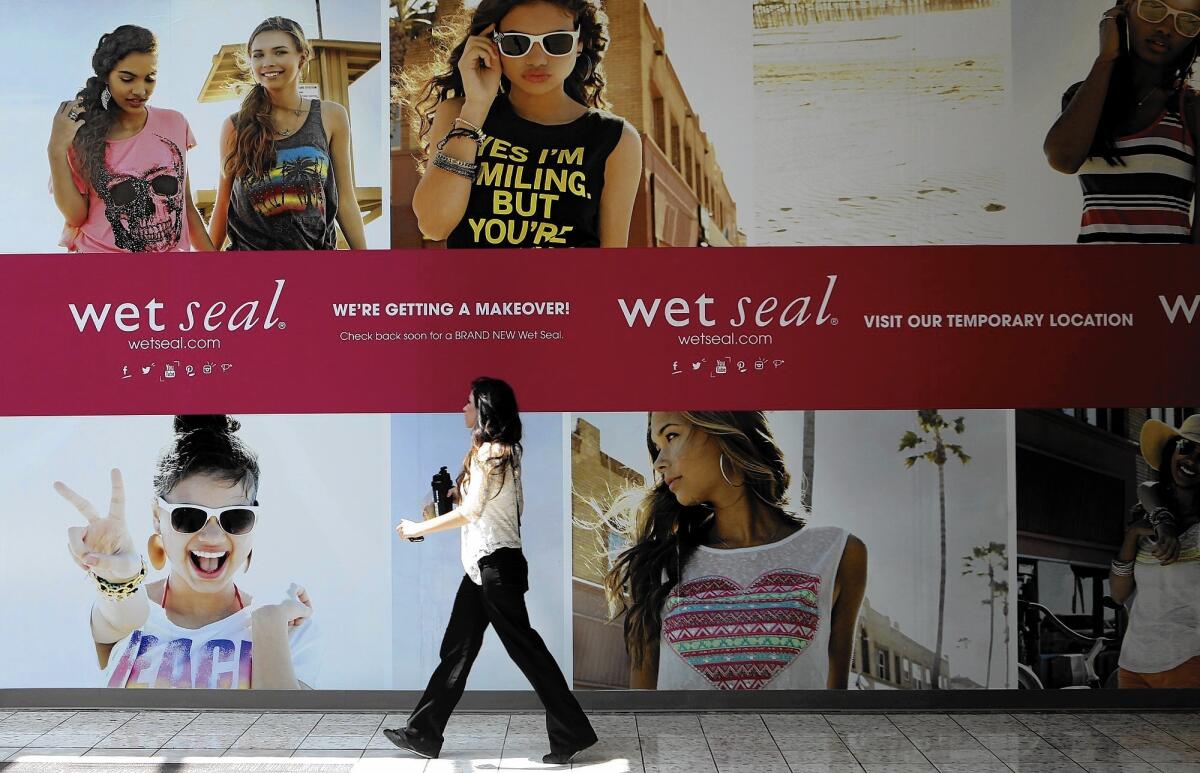Struggling retailer Wet Seal to shut 338 stores

- Share via
Orange County retailer Wet Seal Inc. pioneered the quick translation of Southern California’s beachy lifestyle into fashions for young women. But now it is trying to avoid drowning in the competitive teen marketplace.
The Foothill Ranch company said Wednesday that it would close 338 stores, or two-thirds of its locations, and lay off nearly 3,700 employees as the retailer tries to stave off bankruptcy and revamp its business. It will continue to operate 173 locations and its online business.
“Our financial condition leaves us no other alternative than to close these stores,” Chief Executive Ed Thomas said in a statement. “This was a very difficult decision to make.”
Wet Seal has suffered in recent years as parents cut back on allowances for their children and older teenagers battled unemployed adults for part-time jobs. Newer “fast-fashion” retailers — Forever 21, H&M and Zara among them — have profited from their ability to jump quickly and cheaply on the latest trends.
Expensive leases for mall space also weighed on Wet Seal. Shopping center rivals, including Abercrombie & Fitch and Aeropostale, have struggled to attract fickle young shoppers. Delia’s Inc., a competing teen chain, filed for Chapter 11 bankruptcy last month and is holding a going-out-of-business sale.
Wet Seal may be heading for the same fate unless it can dramatically overhaul its brand and perhaps find a buyer, analysts said.
“The best chance of survival is to take the company private and in turn revitalize the company,” said Britt Beemer, founder of America’s Research Group. “At the rate they are going now, they won’t be here next year.”
The announcement of the closings follows an outpouring of anger on social media this week by workers who said they were suddenly told they were losing their jobs.
Photos of handwritten signs taped to some Wet Seal storefronts went viral online with hashtags such as #ForgetWetSeal and #BoycottWetSeal.
Taylor Bowlin, an assistant manager at a Wet Seal in Greenwood Park Mall in Indiana, said her store’s managers were informed Friday that the store was being closed the following Thursday. No one will receive payouts for unused vacation or sick days, she said.
“It’s truly crazy. It was a big shock, especially coming so suddenly,” Bowlin said. “We all have bills and car payments and families, and our job was just taken from us.”
Wet Seal’s troubles started before the Great Recession, analysts said. The chain has wrestled for years to define its identity; it acquired other merchants and rolled out new brands, but never managed to resonate for long with fashion-conscious shoppers.
The chain’s woes were apparent in the lackluster sales at the locations that are being closed. Although they represent 66% of Wet Seal’s stores, they accounted for only 48% of the $316 million in net sales for the nine months that ended Nov. 1, the retailer estimated. The company had not released a list of which stores were closing as of late Wednesday.
The chain got its start in 1962 as a stand-alone swimwear shop in Newport Beach, originally named Lorne’s, after founder Lorne Huycke.
The name was changed a few years later, according to a company history, after the founder’s wife saw a model strutting down a runway clad in a black bathing suit and described her as looking like “a wet seal.”
The retailer rapidly expanded in the 1980s and ‘90s, even adding for a time a chain selling unisex teen clothes called Limbo Lounge. The chain went public in 1990 and later acquired more than 200 Contempo Casual stores from Neiman Marcus Group.
But Wet Seal never carved out the kind of strong brand that would distinguish it from competitors also pushing clothes for the middle school and high school set, observers said. Its venture into fashions for older women, called Arden B., also proved unsuccessful and was eliminated last year.
“They never had a unique identity and were one of many that were kind of in that era,” Beemer said.
Competition for teenagers has only increased as young shoppers flock to the new generation of fast-fashion rivals that can rush items into stores only a few weeks after a trend is spotted.
In addition, consumers are no longer shopping en masse at enclosed malls, where many Wet Seal stores are located, Beemer said. Before 2001, nearly 40% of American shoppers would browse in a traditional shopping center during the holidays. This year, only one weekend in December attracted more than 20% of shoppers to enclosed malls.
“Wet Seal is part of that problem,” he said.
The company has lost more than $150 million in the last two complete fiscal years. In its third quarter that ended Nov. 1, Wet Seal reported a loss of $36 million, compared with a loss of $12.5 million a year earlier.
The turmoil in its finances has been reflected in boardroom drama. Wet Seal has had three CEOs in the last four years. In 2012, activist shareholder Clinton Group succeeded in ousting most of its board members, including the chairman.
The company also became mired in a racial bias lawsuit alleging that it fired black employees so it could hire white workers. In 2013, the retailer paid $7.5 million to settle that suit.
Now Wet Seal has to figure out a way forward — or risk becoming extinct.
Several analysts said the best path forward is to file for bankruptcy, restructure and find a buyer. Wall Street investors appear to be hoping for a sale; they drove the company’s stock to nearly 13 cents a share Wednesday from 7 cents the day before. That’s down from a trading peak of $2.75 nearly a year ago.
Last month, the company said there was “substantial doubt” it could continue operating. Last week, the retailer said it had received a default notice on $27 million in debt. The company’s creditor has given it until Jan. 12 to pay what it owes.
“The best way to get out of leases on retail stores that aren’t performing is through Chapter 11,” said Ron Friedman, a retail expert at accounting firm Marcum. “Their choices are raise more capital, get rid of all your bad stores and downsize.”
More to Read
Inside the business of entertainment
The Wide Shot brings you news, analysis and insights on everything from streaming wars to production — and what it all means for the future.
You may occasionally receive promotional content from the Los Angeles Times.










